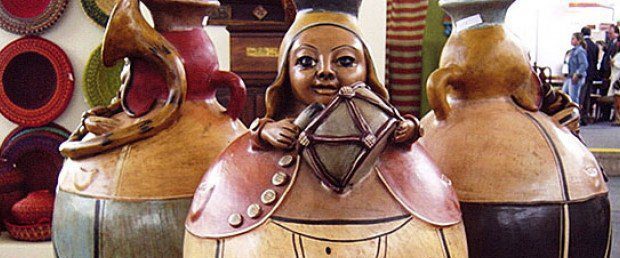Description
El arte de los ceramistas de Chulucanas es un tesoro ancestral cultivado desde las culturas pre-incas Tallanes y Vicús (500 años D.C); su técnica desciende del pueblo de Simbilá, tierra de alfareros quienes al emigrar a Chulucanas llevan la técnica de alfarería. Hoy, en Simbilá se continúa elaborando cerámica utilitaria.
Las características de la elaboración de la cerámica de Chulucanas es el resultado de una mezcla de factores donde intervienen elementos como la arcilla, la arena, el clima y la hoja de mango, así como el uso de técnicas tradicionales de positivo negativo y ahumado y herramientas de las zonas rescatadas de las culturas precolombinas Vicús y Tallanes.
Se elabora en el distrito de Chulucanas ubicado en la provincia de Morropón, departamento de Piura, en la costa norte del Perú. Se ubica a 60 kilómetros al este de la ciudad de Piura y lomita con Ayabaca, Huancabamba y Lambayeque.
El proceso de producción, se inicia con la recolección de la arcilla, materia prima básica de las canteras aledañas a Chulucanas y concluye con los acabados finales después de un largo trabajo utilizando la técnica del paleteo, que se realiza en el moldeo a mano y con golpes de paleta, el uso de pigmentos naturales, el método de decoración de la ‘pintura negativa’ basado en la reducción del oxígeno en la cocción y el ahumado con hojas de mango. Las características más predominantes de la cerámica es el uso de tonos negros, las figuras ovaladas y los diseños geométrico. Las temáticas son mayormente costumbristas.
Chulucanas alberga a grandes familias de ceramistas descendientes de los antiguos tallanes y vicús El pueblo de la Encantada se encuentra a cinco kilómetros de Chulucanas y allí están ubicadas muchas de las familias tradicionales de ceramistas
La cerámica de Chulucanas en sus inicios desarrolló tanto, cazuelas, tinajas y cántaros, como figuras escultóricas costumbristas. Las primeras figuras inspiradas en las ollas, cántaros y tinajas para la elaboración de la chicha de jora y fueron las que dieron la característica posterior de ser siempre redondas y robustas, busca representar a través de su arte las vivencias, costumbres y tradiciones de la región; es por ello que muchas de las obras representan bailes típicos, como marinera y tondero y algunos personajes tienen forma redonda y voluminosa.
Las piezas de cerámica de Chulucanas de la actualidad son de estilo tradicional y contemporáneo. Destacan las piezas decorativas como escenas costumbristas típicas de la región, de todo tamaño y forma; así como piezas modernas influenciadas por los principios estéticos actuales y las necesidades acorde a las tendencias del mercado.
En septiembre del 2005, la Comisión Nacional de Productos Bandera (organismo peruano que tiene por fin establecer una oferta exportable y consolidar su presencia en mercados internacionales), reconoce a la cerámica de Chulucanas como Producto Bandera.
En julio del 2006, a solicitud de CITE Cerámica, de la Asociación de Ceramistas Vicús de Chulucanas y de la Asociación de Ceramistas Tierra Encantada, INDECOPI otorgó la Denominación de Origen a la Cerámica de Chulucanas.
English
Chulucana pottery
The art of the potters of Chulucanas is an ancestral treasure cultivated since the pre-Inca Tallanes and Vicús cultures (500 years A.D.); their technique descends from the people of Simbilá, land of potters who, when they migrated to Chulucanas, took the pottery technique with them. Today, in Simbilá they continue to make utilitarian pottery. The characteristics of the pottery production are the result of a mixture of factors involving elements such as clay, sand, climate and mango leaves, as well as the use of traditional techniques of positive negative and smoked, using tools from the areas rescued from pre-Columbian cultures.
It is made in the district of Chulucanas located in the province of Morropón, department of Piura, on the northern coast of Peru. It is located 60 km east of the city of Piura and is bordered by Ayabaca, Huancabamba and Lambayeque. The production process begins with the collection of the clay, the basic raw material from the quarries near Chulucanas, and concludes with the final finishing touches after a long period of work using the ‘paleteo’ technique, which involves moulding by hand and with trowel strokes, the use of natural pigments, the ‘negative painting’ method of decoration based on the reduction of oxygen during firing and the smoking with mango leaves. The most predominant characteristics of the ceramics are the use of black tones, oval figures and geometric designs. The themes are mostly customary.
Chulucanas is home to large families of potters descended from the ancient tallanes and vicús. The village of La Encantada is five kilometres away and many of the traditional families of potters are located there. This pottery produces both pots, jars and pitchers, as well as sculptural customary figures. The first figures were inspired by the pots, pitchers and jars used to make chicha de jora, and were the ones that gave the later characteristic of always being round and robust, seeking to represent through their art the experiences, customs and traditions of the region; that is why many of the works represent typical dances and some characters have a round and voluminous shape.the ceramic pieces of Chulucanas, among which the decorative pieces with typical customary scenes of the region stand out.
In September 2005, the National Commission of Flagship Products (a Peruvian organisation whose aim is to establish an exportable offer and consolidate its presence in international markets), recognised this pottery as a Flagship Product. In July 2006, at the request of CITE Cerámica, the Vicús de Chulucanas Ceramists‘ Association and the Tierra Encantada Ceramists’ Association, INDECOPI granted the Denomination of Origin to Chulucanas ceramics.


Reviews
There are no reviews yet.